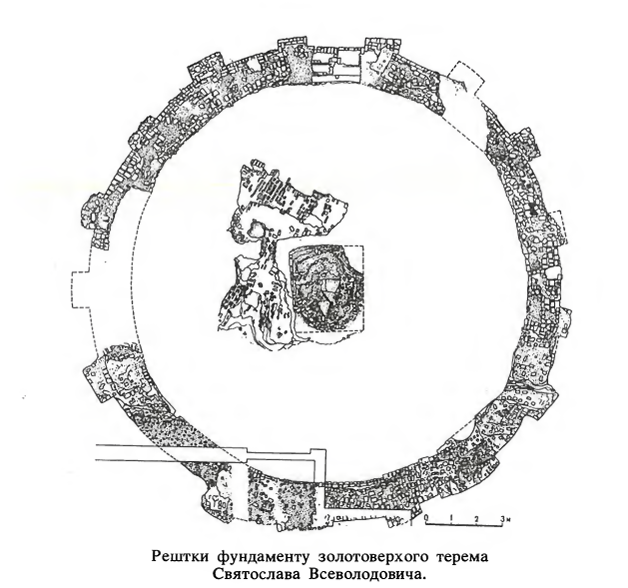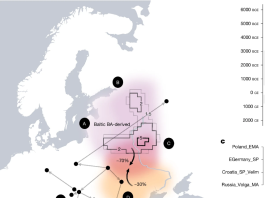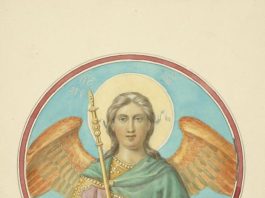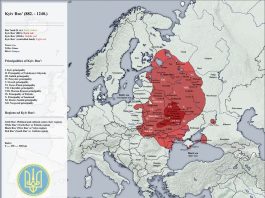According to the Ukrainian Wikipedia page Kyiv Rotunda, the foundations of a large building of the 12th century situated across from the Church of the Tithes were discovered in 1872. The Church of the Tithes was the first stone church of Kyiv Rus that was built by the order of Kyiv King Volodymir the Great between 989 and 996.
In 1975, during the full archaeological research, P. Tolochko and Y. Borovskyi discovered a unique, round-plan architectural structure that had been built before the Mongol-Tatar invasion of the 13th century.
The foundations of the rotunda were a mixture of whole and crushed plinths, boulders, and small stones, filled with clay mortar mixed with lime and cement mortar.
The walls survived to a height of 0.8 m and a thickness of 1.5 m. The outer and inner surfaces of the walls were divided by 16 flat pilasters. A part of a collapsed wall was found in the rotunda, built up sequentially with plinth and cobblestones on cement mortar. A fragment of an arched lintel (window or niche) with a radius of 1.2 m has been preserved. The walls were about 10 m high. In the center of the rotunda, a round pillar with a diameter of 3.2 m was examined, the foundation was traced at a depth of 0.6 m, the preserved height was 1.1 m. During the excavations, molded plinths, pieces of plaster with frescoes, multi-colored glazed ceramic tiles, fragments of slate, and a fragment of a lead sheet were found.
The Kyiv rotunda was a tower-type architectural structure decorated with pilasters. The interior was a hall with a powerful central pillar that served as a support for the ceiling. The walls were decorated with frescoes, the floor was covered with ceramic and slate tiles.The entrance to the building was on the west side. The purpose of the rotunda is interpreted differently: a palace building, a chamber for the king’s councils, and state receptions.
Leonid Makhnovets (1919-1993) was a Ukrainian literary critic, historian, archaeologist, interpreter, and bibliographer. He was a Doctor of Philological Sciences (1966) and a recipient of the Shevchenko National Prize (1990) for preparing and publishing the ‘Chronicle Ruthenian‘. In 1955–72, Makhnovets worked in the Shevchenko Institute of Literature, from where he was groundlessly fired. (Note: He was fired for expressing an unfavorable opinion about Catherine II ‘the great’ of Muscovy in one of his works).
Only an invitation to work at Harvard University forced the Soviet government of Ukraine to allow him to return to scientific research. In 1975-85, Makhnovets worked as a researcher at the Institute of Archaeology (National Academy of Sciences of Ukraine). Makhnovets translated and commented The Tale of Igor’s Campaign, the poem about the raid of Igor Svyatoslavich against the Polovtsians in 1885.
In his book ‘About the Author of the Song of Igor’s Campaign‘, published in 1989, L. Maknovets expressed his opinion about the Kyiv Rotunda:
“The Rotunda-tower with its massive walls was a two-story fundamental structure of large dimensions (about 230 square meters), designed for use in all seasons. Then the question inevitably arises: where is the heat source? A niche in the wall 240 cm wide and 90 cm deep is nothing more than a recess for a fireplace, an open, doorless stove in the wall with a direct chimney. A similar fireplace in the wall is, for example, the round tower (1214) of Turaida Castle near Riga. All medieval castles and palaces in Europe were heated in this way. Fireplaces were in operation for centuries. Kyiv, which lived in close contact with the West and the East, was no exception…“
The second floor of the Rotunda opened a panoramic, breathtaking view of Kyiv Cathedrals and “the silver-steel distance” of the Dnieper River in the northern, Vyshgorod direction.
“But why did the excavations show that the (central) pillar had such a large diameter? Why was it round and not square? The pillars-columns even in Sofia (Kyiv Cathedral) were much thinner and square. It was round because a spiral staircase was built around it, which led to the second floor through an opening in the ceiling. Such spiral staircases, especially in the corners of the halls, are known in many buildings. Here, the staircase was in the middle, as dictated by the architecture of the tower…
… I mean the audience before whom the ‘Song’ was delivered. These were the ‘brothers’, princes and princely sons, princesses and princesses, who gathered on August 15, 1185, in the golden-domed tower of Svyatoslav III of Kyiv. These were people who were as thoroughly informed about the history of Rus, about events in it, and not only in it, as the author of the ‘Song‘.”
August 15, 1185 was the very day when Igor, having escaped captivity, came to Kyiv as the last verses of the epic tell us. He was among the guests listening to the ‘Song‘.
How do we know that the Rotunda was golden-domed? The author of the ‘Song‘ tells us this in the following passage:
“And Svyatoslav saw a troubled dream in Kyiv upon the hills: “This night, from eventide, they dressed me,” he said, “with a black pall on a bedstead of yew. They ladled out for me blue wine mixed with bane. From the empty quivers of pagan tulks they rolled great pearls onto my breast, and caressed me. Already the traves lacked the master-girder in my gold-crested tower!”
Dr. L. Makhnovets convincingly proved that the author of the timeless epic ‘The Song of Igor’s Campaign‘ was Prince Volodymir II of Galych, a son of King Yaroslav Osmomysl. Only such a title could allow the author of the epic to address the royal elite of Kyiv Rus who gathered that day at the palace as ‘brothers and sisters’.
The famous Yaroslavna (which means the daughter of Yaroslav) of the ‘Song’, who wept in Putyvl was Volodymir’s sister. And since Yaroslavna was Igor’s wife, Volodymir and Igor were brothers-in-law. At the time of the campaign, Volodymir was in Putyvl and received all the information first-hand from many sources, including his sister who moved from Novgorod-Siversky under protection of her brother.
Another researcher of the epic, V. Chivilikhin, also observed:
“It has been calculated that the author of the ‘Song’ directly named thirty princes, collectively – other seven or eight, hinted at three more; in total, there are forty princes and four princesses, and if we count and sum up the repeated mentions (Igor is named, for example, thirty-three times), then we get the following result – in a poem of tiny volume, the reader’s attention is drawn to representatives of eight generations of the princely class about a hundred times! And not a single genealogical error, not a single name mentioned out of place in almost two hundred years of the history of [Kyiv] Rus!
This knowledge, with which the author freely operates, could not be acquired on the side. The use of dozens of names of princes is always appropriate, with the most subtle shades of meaning when describing their deeds, with lapidary statements on the long history of civil strife, with many private and even intimate details, was available only to the author, who knew the princely family traditions and secrets and, most likely, belonged to this highest class of Rus…”
‘Gardariki, Ukraine‘ ebook has more facts and insights about Kyiv Rus history that can change the perception of the realm.







